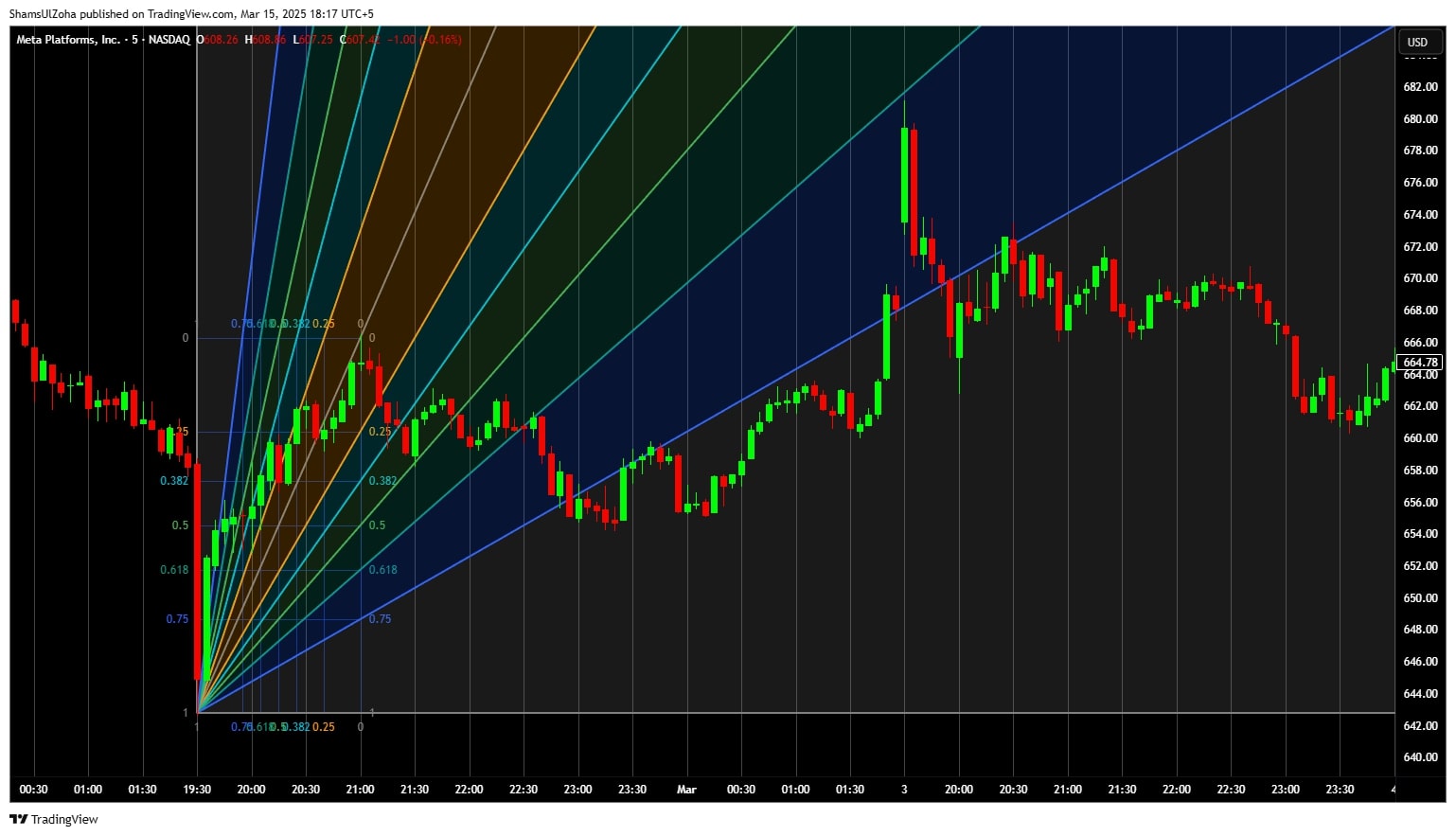The Fibonacci Fan is a powerful trading indicator in technical analysis that helps traders identify potential support levels, resistance levels, and trend reversals. It is based on Fibonacci retracements, which originate from the Fibonacci sequence, discovered by the Italian mathematician Leonardo Fibonacci. These Fibonacci ratios are widely used in financial markets to predict future price movements and make informed trading decisions.
This tool consists of fan lines drawn from a significant swing high or swing low, extending outward at Fibonacci retracement levels to project potential price levels. It acts as a trend line tool to gauge price pullbacks, continuations in price movement, and potential reversals.
Imagine a rising staircase where each step represents a strong level of support or resistance. As stock prices move, they may react at these key levels, making Fibonacci Fan analysis a crucial component of trading strategies for successful traders.

Fibonacci tools are especially useful for traders who prefer technical indicators that provide structured, rule-based trading decisions. The predictive power of these tools helps traders reduce market noise and focus on potential price movements.
How the Fibonacci Fan Works in Trading?
The Fibonacci Fan is constructed using a trendline that connects a significant high and low point on the price chart. The retracement levels (23.6%, 38.2%, 50%, and 61.8%) are then used to draw additional lines that fan out from the base trendline.
These fan lines represent areas where price action may stall, reverse, or breakthrough, making them useful for identifying trade opportunities.
- In an uptrend, Fibonacci Fan lines below the price act as potential support levels.
- In a downtrend, Fibonacci Fan lines above the price act as resistance levels.
To construct a rising Fibonacci Fan, traders:
- Identify a swing low and a swing high in an uptrend.
- Draw a trendline connecting these two points.
- Plot Fibonacci retracement levels downward and extend lines from the swing low.
For a Downward Movement, traders:
- Identify a swing high and a swing low in a downtrend.
- Draw a trendline connecting these two points.
- Plot retracement levels upward and extend fan lines from the swing high.
Traders use Fibonacci fan lines to identify opportunities for traders based on potential support levels and resistance lines. If price bounces off a fan line, it indicates a strong level of support or resistance. If price breaks through, it suggests a trend continuation or potential resistance breakout.
Systematic Trading Perspective: Why Rules Matter
Many traders struggle with bad predictions due to market noise and emotional reactions. The Fibonacci Fan provides a structured approach for trading decisions by defining potential price levels based on technical analysis tools.
Backtesting the Fibonacci Fan allows traders to see if it has historical significance in specific markets. Traders can enhance their strategy and evaluate if Fibonacci levels provide a reliable trading advantage by experimenting with various timeframes and settings.
A systematic approach using Fibonacci Fans might include:
- Entry Signals – Buy when price finds support at a key level; sell when price faces resistance levels.
- Stop-Loss Placement – Set stops beyond the nearest fan line to avoid false signals.
- Trade Confirmation – Combine with candlestick patterns, moving averages, and momentum indicators for accurate predictions.
This approach to trading helps traders reduce financial risk and make informed trading decisions.
Challenges of Using the Fibonacci Fan in a Trading System
While the Fibonacci Fan is a valuable tool, it is not 100% reliable. Traders must be aware of common pitfalls and learn how to mitigate risks.
One limitation is false signals. Price may break through a fan line temporarily before reversing. To avoid getting caught in fake breakouts, traders should look for confirmation signals from other technical indicators.
Another challenge is market conditions. The Fibonacci Fan works best in trending markets, where prices move in clear uptrends or downtrends. In sideways markets, the fan lines may provide inconsistent signals, leading to poor trade execution.
Overfitting is another risk. Traders sometimes over-optimize Fibonacci settings to fit past data, but this does not guarantee future success. The best approach is to test multiple markets and timeframes to identify general rules that work consistently.
How to Avoid False Signals When Trading with Fibonacci Fans?
To reduce the risk of acting on false signals, traders should validate breakouts or reversals before executing trades. Below are key strategies to improve the reliability of Fibonacci Fan signals.These fake breakouts can lead to losses if traders enter or exit positions prematurely.
To reduce the risk of acting on false signals, traders should use confirmation techniques to validate breakouts or reversals before executing trades. Below are some key strategies to improve the reliability of Fibonacci Fan signals.
Confirm with Candlestick Patterns
Candlestick patterns provide real-time price sentiment and can help determine whether a breakout is genuine or a trap.
- Bullish confirmation: Look for a strong bullish engulfing candle, hammer, or a series of higher closes after the price interacts with a fan line.
- Bearish confirmation: Look for a bearish engulfing candle, shooting star, or a long upper wick near resistance, signaling a rejection of higher prices.
If the price pierces a fan line but quickly forms a rejection candle, it suggests the breakout is weak, and a reversal may occur.
Use Moving Averages for Trend Confirmation
Moving averages help smooth price action and can confirm whether the price is breaking out with momentum or simply experiencing temporary volatility.
- A break above a Fibonacci Fan resistance line should also push the price above a key moving average (such as the 50-day or 200-day MA) to confirm the trend continuation.
- If the price briefly moves above a fan line but remains below the moving average, the breakout is likely false, and the price could reverse.
Moving averages filter out market noise, ensuring traders focus only on strong-trend moves.
Volume Analysis: Watch for a Volume Surge
One of the biggest giveaways of a fake breakout is low volume. If price breaks through a Fibonacci Fan line but is not accompanied by a significant increase in volume, it suggests that the move lacks strength and may reverse.
- Valid breakout: This should occur with a noticeable spike in volume, confirming market participation.
- False breakout: If the price moves beyond a fan line with weak or declining volume, it signals that traders are not fully committed to the move.
Traders can confirm movements using volume indicators such as On-Balance Volume (OBV) or Volume Weighted Average Price (VWAP).
RSI & MACD for Momentum Confirmation
Momentum indicators, such as the Relative Strength Index (RSI) and the Moving Average Convergence Divergence (MACD), can help confirm whether a breakout is sustainable.
- If price breaks above a Fibonacci Fan line, RSI should be above 50 to confirm bullish momentum.
- If price breaks below a fan line, RSI should be below 50, confirming bearish strength.
- MACD should show a bullish crossover (MACD line above the signal line) for long trades and a bearish crossover for short trades.
If price moves beyond a Fibonacci Fan line, but RSI remains weak or MACD does not confirm momentum, the breakout could be false.
Conclusion & Next steps
Fibonacci fans should not be used in a systematic trading strategy because they are inherently subjective and lack the rule-based precision required for robust backtesting. The placement of fan lines depends on visually chosen swing points, and small variations in these anchor points can produce entirely different results, undermining consistency and reliability. Since the indicator’s signals cannot be objectively defined or coded into a repeatable algorithm, it becomes impossible to test their historical validity or assess their true predictive power. As a result, Fibonacci fans introduce discretion and bias into what should be a data-driven process, making them unsuitable for systematic trading where replicability and statistical verification are essential.
If you’re ready to improve your trading today and avoid the pitfalls of discretionary decision-making, apply now to The Trader Success System. It’s designed to help you build trading strategies that are robust and proven to match your goals, lifestyle and risk tolerance.


